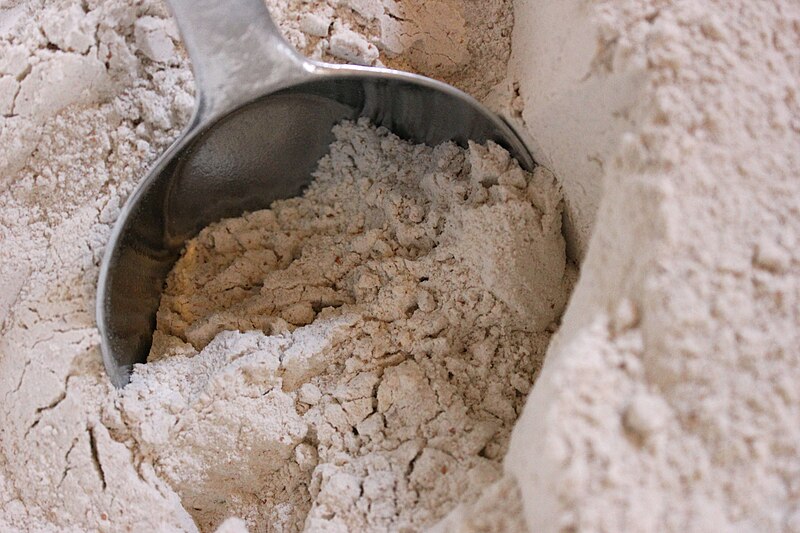Nutrition for Whole Wheat Flour
Calories, Protein, Vitamins and More
Whole Wheat Flour Nutrition Summary
One cup of whole wheat flour (137 grams or 0.3 lb) contains 455 calories and 13.2 grams of protein. Whole wheat flour consist of 12% water, 75% carbohydrates, 10% protein, and 2% fat.Whole wheat flour is an excellent source of many nutrients, including carbohydrates, dietary fiber, protein, calcium, iron, magnesium, potassium, thiamin and niacin. It also contains significant amounts of riboflavin, Vitamin B6, pantothenic acid, zinc, selenium, choline, manganese, copper and phosphorus.
In one cup of whole wheat flour:
- Calories: 455
- Protein: 13.2 g
- Sugar: 1.4 g
- Dietary fiber: 17.9 g
- Fat: 2.7 g, (Saturated: 0.6 g)
- Sodium: 4.1 mg
See the Whole Wheat Flour Nutrition Chart for complete recommended daily values.
The specific nutritional values from USDA is for: Wheat flour, whole-grain, soft wheat.
Calories in Whole Wheat Flour
Whole wheat flour has 455 calories per cup or 332 calories for every 100 grams. Most of its calories are from carbohydrates and protein.84% of calories in whole wheat flour are from carbohydrates, 11% of calories are from protein and 5% of calories are from fat.
Calories from Carbs
The majority, or 84% of the calories in whole wheat flour are from carbohydrates.
The carbs in whole wheat flour are mostly in the form of dietary fiber and sugar (93% and 7%). An excellent high-fiber food, a single cup of whole wheat flour contains 72% of recommended daily values or 17.9 grams of dietary fiber.
- Dietary fiber: 17.9 g
- Sugar: 1.4 g
Calories from Fat
A small portion, or 5% the calories in Whole Wheat Flour are from fat. Whole wheat flour has a moderate amount of total fat, with 2.7 grams or 4% of recommended daily values per cup. Most of the fat in whole wheat flour are healthier unsaturated fats.
Whole wheat flour is cholesterol free and trans-fat free.
Whole wheat flour is cholesterol free and trans-fat free.
- Total fat: 2.7 g
- Saturated fat: 0.6 g
- Monounsaturated fat: 0.4 g
- Polyunsaturated fat: 1.6 g
Calories Similar to Whole Wheat Flour
Some other grains or pasta with similar calories to whole wheat flour by weight:- Barley: +27 calories
- Wheat Germ: +38 calories
- Wheat Flour: +40 calories
- Flour: +44 calories
Protein in Whole Wheat Flour
An excellent source of protein, a single cup of Whole Wheat Flour contains 26% of recommended daily values or 13.2 grams of protein. However, the protein in whole wheat flour is not complete, meaning it does not contain all 9 essential amino acids. Specifically, whole wheat flour is low in tryptophan, threonine, isoleucine, leucine, lysine, methionine, phenylalanine, valine and histidine.- Protein: 13.17 g
Protein Similar to Whole Wheat Flour
Some other grains or pasta with similar amounts of protein to whole wheat flour by weight:- Cornmeal: +0.3 grams
- Barley: +0.4 grams
- Flour: +1 grams
- Wheat Flour: +3.2 grams
Vitamins and Minerals in Whole Wheat Flour
An good source of many nutrients, whole wheat flour contains abundant amounts of calcium, iron, magnesium, potassium, thiamin and niacin. In fact, a single cup of whole wheat flour contains 52% of recommended daily values or 7.3 milligrams of niacin. Also a great source of magnesium, a single cup of whole wheat flour contains 52% of recommended daily values or 160.3 milligrams of magnesium.Vitamins in whole wheat flour (1 cup):
- Vitamin a: 3.7 ug
- Thiamin: 0.4 mg
- Riboflavin: 0.3 mg
- Niacin: 7.3 mg
- Vitamin b6: 0.3 mg
- Vitamin e: 0.7 mg
- Folate: 38.4 ug
- Vitamin k: 2.6 ug
- Calcium: 45.2 mg
- Potassium: 539.8 mg
- Iron: 5.1 mg
- Magnesium: 160.3 mg
- Zinc: 4.1 mg
- Selenium: 17.4 ug
- Phosphorus: 442.5 mg
- Copper: 0.7 mg
- Manganese: 4.7 mg
- Choline: 42.7 mg
Similar to Whole Wheat Flour for Niacin (Vit B3)
Here are some other grains or pasta with similarly abundant amounts of niacin (Vit B3) to whole wheat flour:- Barley: -1 MG
- Wheat Germ: +2 MG
- Pasta: +2.5 MG
- Wheat Flour: +3 MG
Flavonoids and Carotenoids in Whole Wheat Flour [3]
Whole wheat flour contains a couple of healthy phytonutrients and antioxidants, specifically carotenoid lutein + zeaxanthin. In one cup of whole wheat flour:
- lutein + zeaxanthin: 301 ug
Whole Wheat Flour Nutrition Chart
|
Whole Wheat Flour:
( -
g )
|
||
|---|---|---|
| calories |
|
KCAL % |
| carbohydrates |
|
G % |
| dietary fiber |
|
G % |
| sugar | G | |
| total fat |
|
G % |
| saturated fat |
|
G % |
| monounsaturated fat | G | |
| polyunsaturated fat | G | |
| protein |
|
G % |
| sodium |
|
MG % |
| Vitamin A |
|
UG % |
| calcium |
|
MG % |
| iron |
|
MG % |
| magnesium |
|
MG % |
| potassium |
|
MG % |
| thiamin (Vitamin B1) |
|
MG % |
| riboflavin (Vitamin B2) |
|
MG % |
| niacin (Vitamin B3) |
|
MG % |
| Vitamin B6 |
|
MG % |
| pantothenic acid (Vitamin B5) |
|
MG % |
| folate (Vitamin B9) |
|
UG % |
| Vitamin E |
|
MG % |
| Vitamin K |
|
UG % |
| zinc |
|
MG % |
| selenium |
|
UG % |
| choline |
|
MG % |
| manganese |
|
MG % |
| copper |
|
MG % |
| phosphorus |
|
MG % |
| Water | G | |
